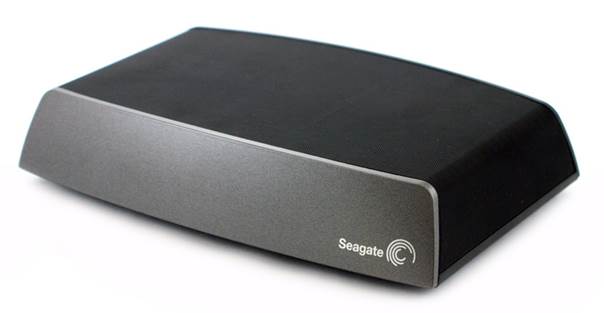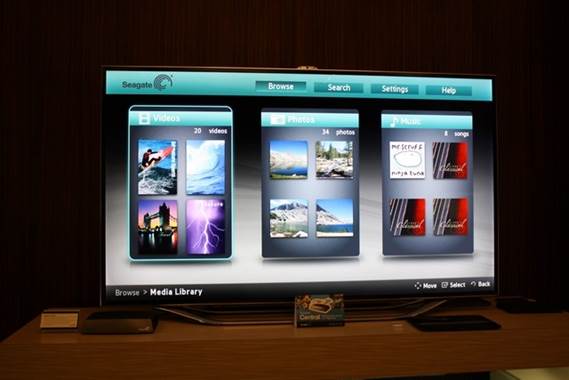Backup
Having access to any content on any device
from anywhere is great, of course, but not nearly as essential as regular
backups. You can easily backup the computer running Windows or OS X, and you
can also do the same with the pictures and videos you've posted on Facebook.
Adding access to your account on the social network is easy enough and once
configured, it will happen automatically using the internet connection of the
Central, so no PC needed. Backing up your Mac is also easy since the Central
shows up like any other available Time Machine backup disc - no need to modify
your Mac to work with unsupported network drives.

Having
access to any content on any device from anywhere is great, of course, but not
nearly as essential as regular backups.
The Windows backup automation is fairly
easy, but includes a few more steps. Not every version of Windows will include
software that will automatically backup to a network drive, so if you do not
want to run them manually, you will want to install the Seagate Dashboard. You
can configure its continuous backup feature to keep your data safe. Although we
try to do, it will work as promised, with our only complaint is its
performance. In these tests, we were only able to read from the Central over
our gigabit network at 64 Mbps, with write speeds averaging around 40 Mbps.
While it is certainly fast enough for most transmission media, it creates a
long backup windows - at least initially.
Media
So we got it set up, got our backups going,
but now it's time to relax and go back to your favorite content. In addition to
what any basic network-attached storage can do with a Samba share, the Central
offers 4 different ways to access content. Two ways are limited to a local area
network (DLNA and iTunes sharing), while Seagate and Seagate Media Remote
Access work from anywhere with an internet connection. The DLNA works exactly
as you expect, as the device follows the defined DLNA guidelines for a Digital
Media Server (DMS). You just need to copy the contents to the appropriate
sub-folder in the Public folder (music, video and images) and the content shows
up on your certified DLNA Digital Media Players. The good thing is that the
iTunes music sharing uses the same music folder, so you can use iTunes on your
Mac or PC to listen to the library without creating another copy of the
collection.

Seagate
Central’s interface
What's more unique than DLNA or iTunes
sharing, though, is Seagate's own Remote Access and Media apps for iOS,
Android, Kindle Fire and Samsung TVs and Blu-ray players with Smart Hub. The
Remote Access is accessible through any web browser that can get to the
access.seagate.com website and provides the ability to upload or download
content to the Central from any device with a web browser. It allows access to
public and private data stored on the Central, but the Seagate Media app can
only access content stored in the public folder when not connected to your
network.
We can only check the iOS version of the
Seagate Media app, and while it does make it easy enough to consume and upload
content, it isn't as tightly integrated or as polished as the native iOS media
apps - for example, when you click on a video was downloaded from the iTunes
store, its first launch web browser, then use the built-in iOS media player.
Another problem is that it is not very fast, with a number of pages leaving you
waiting for what seems like forever to load a list of content (which surely
should only take a few seconds). In addition to this complaint, the application
allows easy access to your media from anywhere and on more than one platform.
It makes it easy by providing both thumbnail and list views as well as filters
that vary by the type of data, like size or type for documents and year or
genre for videos.
Conclusion
In summary, what we have here is the first
hard drive attached to your network, with the ability to share content using
common protocols, as well as applications for most mobile devices. And that's a
good thing. When you consider it only costs about $60 more than the same size
bare hard drive, it isn't hard to see the value in the Seagate Central. It
makes backing up your computer easier, and it also helps you more easily view
content across various devices. Certainly there are many other network-attached
drives so far, but Seagate create a unique combination that will certainly make
it stand out for some people who need the solution regardless of the device.

In summary, what we have here is the
first hard drive attached to your network, with the ability to share content
using common protocols, as well as applications for most mobile devices.
Info
·
Price: $189
Pros
·
Access DLNA, iTunes, browsers and applications
·
Backup Facebook content automation
·
Not too expensive compared with universal hard
drives.
Cons
·
Seagate Media iOS app may slow
·
The iTunes sharing works only with music
Verdict
·
This is an attractive solution for sharing media
center and network backup, with an affordable price.

An
attractive solution for sharing media center and network backup
Technical specs
|
General
·
Total drive bays: 1
·
Occupied drive bays: 1
·
Drive type: Platter
·
Included storage: 2/3/4 TB (total)
·
Addressable storage: 2/3/4 TB (max)
Networking
·
Ethernet: 10/100/1000 [Gigabit]
Services
·
Media services: DLNA, UPnP
Power
·
Power adapter: External
Size & weight
·
Dimensions: 1.65 inches (h) x 8.5 inches (w) x
5.71 inches (d)
·
Weight: 216.05 pounds
|